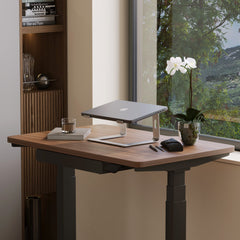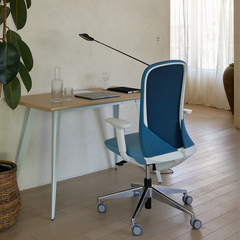Get 10% off your first order
Find the office furniture that’s designed to match your style, comfort, and needs perfectly. Subscribe
The Shape of Focus: How Furniture Design Influences Remote Work Habits

Visit quiz page to see how we makes it easy to create an inspiring workplace

Remote work transformed homes into full-time offices, and the chair became the foundation of daily performance. Comfort is not indulgence—it’s the gateway to consistent productivity. A properly designed seat supports spinal alignment, promotes blood flow, and sustains energy. Over time, this translates to improved focus, fewer interruptions from discomfort, and a healthier relationship with work.
Good ergonomics start with posture geometry. The spine should maintain its natural S-curve, feet must rest flat, and elbows should form roughly a 90-degree angle. The monitor should meet the eyes, not the neck. These principles are reinforced by the CDC’s ergonomic guidelines, which emphasize neutral positioning and frequent movement. Whether your choice leans gaming or executive, these fundamentals remain constant.

The gaming chair’s DNA stems from racing car seats built for endurance. High backs, bucket-style contours, and recline features promote dynamic sitting. For remote work, this translates to comfort during long sessions that blend focus and flexibility. The design encourages active posture rather than passive slouching.
Gaming chairs excel in range of motion, offering multi-angle recline, customizable tension, and responsive armrests that move in multiple directions. These features promote micro-movements—small shifts that sustain circulation and mental sharpness throughout the day.
Four-dimensional armrests can be adjusted vertically, laterally, and pivoted inward or outward to maintain relaxed shoulders. This prevents upper body fatigue common in fixed-arm setups.
Dynamic tilt mechanisms encourage gentle rocking motions that help oxygenate the body. Over time, these subtle changes in posture enhance focus and comfort.
Gaming-style chairs often use external lumbar cushions and adjustable headrests that adapt to the user’s proportions. The Novo ergonomic chair with gaming-inspired support demonstrates how this flexibility benefits remote workers seeking both comfort and control in their daily environment.
Executive chairs traditionally convey authority, yet modern iterations focus on comfort and ergonomic integrity. They combine refined aesthetics with technical support systems designed for hybrid environments. The Muse executive chair for hybrid offices embodies this evolution with its understated profile and smooth adjustment mechanics that maintain composure on and off camera.
Mesh, leather, and hybrid textiles each deliver distinct ergonomic advantages. Mesh supports airflow in warm spaces, while padded foam structures maintain even weight distribution for prolonged sitting. These material decisions are more than stylistic—they influence how long professionals can sit productively without strain.
Integrated lumbar curvature and balanced seat pan angles promote consistent posture without the need for constant readjustment. Executive designs focus on equilibrium: upright support, stable tilt, and smooth transitions from one sitting position to another.
| Category | Gaming Chair Strength | Executive Chair Strength |
|---|---|---|
| Posture Strategy | Dynamic flexibility for active work styles | Stability and formality for long, focused sessions |
| Adjustability | Extensive control over armrests, recline, and lumbar depth | Simplified adjustments for consistent posture |
| Visual Presence | Expressive contours and color options | Professional minimalism that suits hybrid offices |
| Ideal User | Designers, gamers, developers | Managers, strategists, client-facing professionals |
| Example | Novo ergonomic gaming-style chair | Muse executive home office chair |
Both designs meet legitimate ergonomic needs; the ideal choice depends on posture habits and personality of work.
For analytical or writing-intensive tasks, chairs with stable posture support help maintain endurance. Executive seating promotes a centered, calm posture that matches extended concentration.
Creative professionals who shift constantly between applications and tools need flexibility. Gaming-style designs with multi-axis adjustments accommodate those micro-shifts in focus and movement.
Executive silhouettes project professionalism during virtual meetings, where posture communicates attention. Consistent alignment reduces visible fidgeting, conveying calm authority.
Compact setups benefit from streamlined chairs that deliver ergonomic support without overwhelming the room. Browse Urbanica home office chair collection to find options tailored for limited layouts and varied body types.
Chair effectiveness depends on workstation geometry. Ideally, your elbows should align with the keyboard surface, shoulders relaxed, and eyes level with the top of the screen. Proper pairing reduces cumulative strain and improves posture endurance. Matching height and surface quality is easier with Urbanica modern desks for remote work that complement ergonomic seating.
A simple footrest or adjustable monitor stand can complete the ergonomic triangle between seat, desk, and screen. Each adjustment should target a specific imbalance rather than attempt to compensate for a poor chair fit.
Ergonomic success depends on harmony between pieces. The Urbanica custom workstation bundles approach helps remote workers plan layouts that balance scale, lighting, and personal workflow patterns for consistent comfort.

Ergonomic chairs distribute pressure evenly across the back and thighs, supporting the spine’s natural curvature. Over time, this alignment prevents discomfort, reduces fatigue, and minimizes the risk of musculoskeletal strain.
Movement promotes alertness. Chairs that allow small shifts keep blood flowing and prevent cognitive dips. Adjustability is not luxury—it’s a subtle health mechanism embedded in good design.
The Onyx ergonomic chair for sustained focus offers balanced tension control and adaptive support, suitable for professionals who need consistent comfort across long projects.
1. Seat height allows feet to rest flat and knees at roughly 90 degrees.
2. Lumbar support fits the natural curve of your lower spine.
3. Armrests meet your elbows without forcing shoulders up.
4. Seat depth leaves a small gap behind the knees.
5. Fabric suits your climate and session length.
6. Recline tension feels stable, not springy.
7. Controls are accessible while seated.
Expect measurable comfort improvements, not miracles. True ergonomic success blends proper fit, desk alignment, and consistent movement breaks. Comfort compounds through daily use and mindful posture habits.
Each fabric type requires specific care. Mesh should be vacuumed to remove dust buildup. Leather and coated materials respond best to soft cloth and mild cleaner. Avoid solvents that degrade coatings or stitching.
Reevaluate chair settings every few months. Adjust lumbar depth, armrest position, and tilt resistance to match evolving work habits. These small recalibrations keep performance consistent over years of use.
Ergonomic preferences reflect environment and culture. Professionals in warmer climates favor breathable mesh materials, while cooler regions gravitate toward padded textures that retain warmth. Scandinavian minimalism prioritizes simplicity and sustainability, while North American offices value multi-function adaptability. Recognizing these tendencies helps both brands and consumers align design with cultural work rhythms.
Urban apartments often demand compact frames and light materials to transition easily between personal and professional zones. Suburban setups can accommodate broader silhouettes with statement profiles. Geography even shapes material durability—coastal humidity benefits from rust-resistant metals, and arid regions perform best with fabrics that manage static and dryness.
As remote work globalizes, ergonomic awareness spreads across markets and cultures. Multinational companies are standardizing posture and seating guidelines to support distributed teams equally. This shared understanding signals a new era where ergonomic design adapts not only to the body but also to cultural and environmental realities.
Advancements in foams, meshes, and composite materials are improving long-term resilience and comfort. The focus is incremental—designers aim to extend lifespan and maintain support without gimmicks or fragile electronics.
Subtle features that help users reproduce their preferred settings after moving or sharing a chair are becoming more common. These small, user-centered refinements matter more than overengineered smart features.
Your day involves frequent task switching, you enjoy active sitting, and you prefer vibrant design. The broader recline range and adjustable armrests can support both creativity and concentration.
You spend long stretches in meetings or strategic planning sessions. You value understated aesthetics, stable posture, and predictable comfort over maximum adjustability.
No matter how appealing the color or silhouette, comfort begins with proportion. Always test for proper seat depth, lumbar contact, and armrest reach.
A seat that’s too long restricts circulation; one that’s too short concentrates pressure. The right depth ensures stability and comfort through long workdays.
Material choice affects comfort across hours. Breathable fabrics maintain comfort in warmer climates, while padded textiles perform better in cooler spaces.
Sometimes variety itself enhances comfort. For reading corners or mobile tasks, the Seashell task chair with adaptive frame provides ergonomic mobility with a minimalist footprint. Rotating between two supportive chairs can prevent overuse fatigue and extend overall sitting endurance.
The dialogue between gaming and executive chair design reflects a larger shift toward human-centered workplaces. Comfort, aesthetics, and health are converging as core values of remote life. The future favors adaptable seating that supports real people—across professions, climates, and living spaces—without overpromising technology or neglecting authenticity. The right chair is not a status symbol but a daily ally in achieving clarity, balance, and sustainable productivity.

The Shape of Focus: How Furniture Design Influences Remote Work Habits

Work That Flows: Designing a Home Office That Actually Works

Choosing a Chair for Hardwood or Tile Floors
Get 10% off your first order
Find the office furniture that’s designed to match your style, comfort, and needs perfectly. Subscribe
Leave a comment